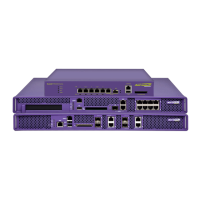Controller Security
Summit WM3000 Series Controller System Reference Guide360
changed back to the specific internal private class IP address in order to reach the LAN over the
controller managed network.
6 Use the Access List drop-down menu to select the list of addresses used during NAT translation.
These addresses (once translated) will not be exposed to the outside world when the translation
address is used to interact with the remote destination
7 Use the Interface drop-down menu to select the VLAN used as the communication medium between
the source and destination points within the NAT configuration. Ensure the VLAN selected
represents the intended network traffic within the NAT supported configuration. VLAN1 is available
by default.
8 Refer to the Status field for the state of the requests made from applet. This field displays error
messages if something goes wrong in the transaction between the applet and the controller.
9 Click OK to use the changes to the running configuration and close the dialog.
10 Click Cancel to close the dialog without committing updates to the running configuration.
Defining Static NAT Translations
Static NAT creates a permanent, one-to-one mapping between an address on an internal network and a
perimeter or external network. To share a Web server on a perimeter interface with the Internet, use
static address translation to map the actual address to a registered IP address. Static address translation
hides the actual address of the server from users on insecure interfaces. Casual access by unauthorized
users becomes much more difficult. Static NAT requires a dedicated address on the outside network for
each host.
Refer to the NAT screen’s Static Translation tab to view existing static NAT configurations available to
controller.
To view and add/edit a dynamic NAT configuration:
1 Select Security > NAT from the main menu tree.
2 Click the Static Translation tab.

